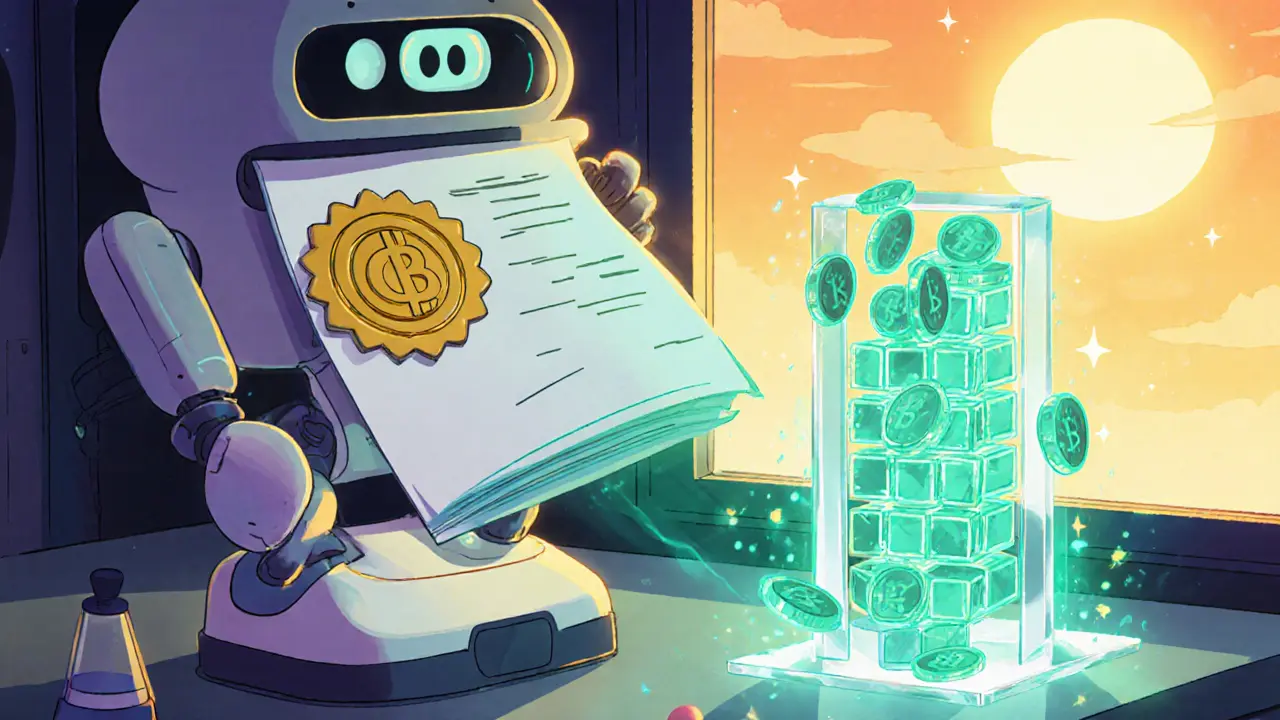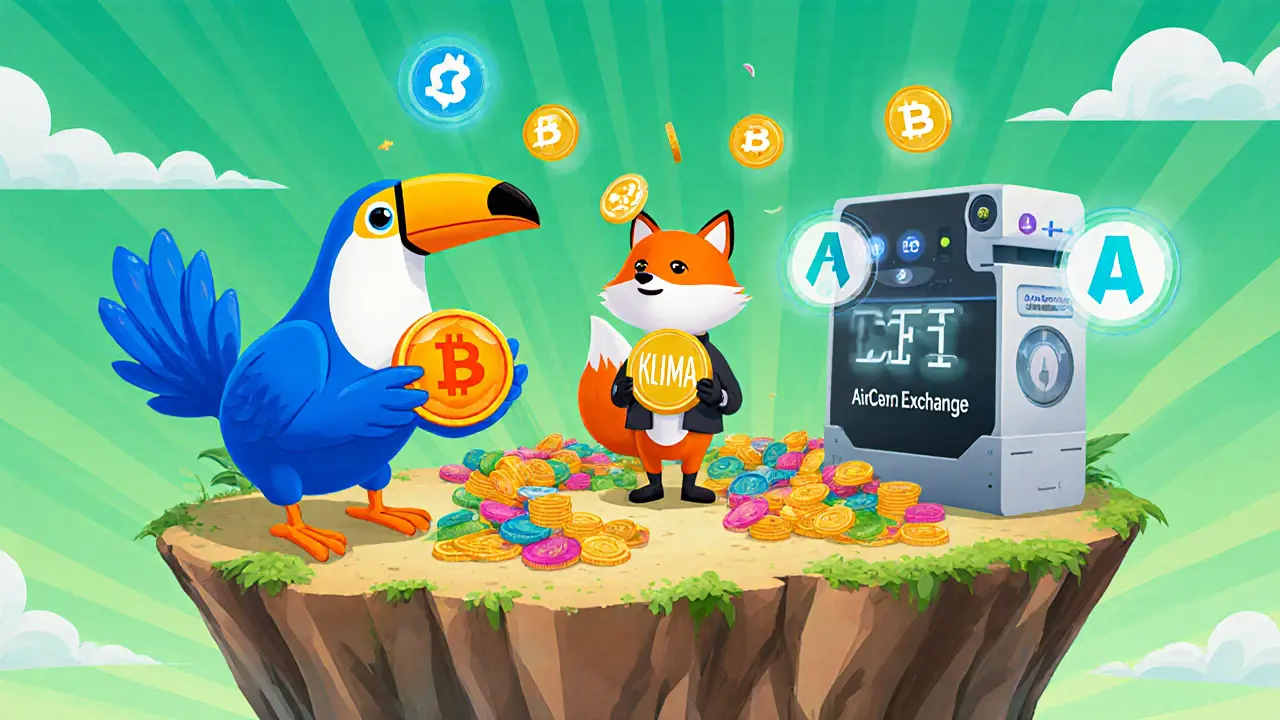 Dec, 9 2024
Dec, 9 2024
Carbon Offset Cost Calculator
Calculate Your Carbon Offset Costs
Estimate the total cost of tokenized carbon credits based on your offset needs, credit type, and blockchain platform.
Key Takeaways
- Tokenizing carbon credits puts climate finance on a public ledger, making every tonne traceable.
- Major platforms - Toucan, Klima, AirCarbon Exchange and others - each solve a different market pain point.
- Liquidity, automation and DeFi composability are the biggest upside, while quality control and double‑counting remain the toughest challenges.
- Corporations like Microsoft and Shopify already use blockchain‑based credits for compliance and brand‑building.
- Regulators are drafting standards; the next wave will likely be a blend of on‑chain protocols and traditional registries.
Carbon Credit Blockchain Projects are a set of distributed‑ledger platforms that digitize, trade and retire verified carbon offsets using crypto‑style tokens. By moving the record of each credit onto an immutable chain, these projects aim to solve the opacity, high transaction costs and double‑counting problems that have plagued the voluntary carbon market for decades.
In the next sections we’ll break down how tokenization works, walk through the most active platforms, compare their core features, and highlight the real business impact you can expect.
How Tokenization Turns a Paper Credit Into a Digital Asset
Traditional carbon credits are issued by registries such as the Gold Standard or Verra. Each credit represents one tonne of CO₂ avoided or removed, and it carries a serial number, project metadata and a retirement status. Tokenization adds a bridge between that registry and a blockchain:
- Verification: The credit is audited by the registry and assigned a unique identifier.
- Retirement on‑chain: A smart contract locks (or “retires”) the original credit, guaranteeing it can’t be double‑counted.
- Minting: The contract creates a semi‑fungible token - often an ERC‑20 on Ethereum - that mirrors the credit’s volume and metadata.
- Fractionalisation: Because the token is divisible, a single credit can be split into 1,000 units, opening it to smaller buyers.
- Trading & retirement: Holders can swap, pool or retire tokens directly from a wallet, with every action recorded on the public ledger.
This workflow preserves the integrity of the original credit while adding the speed, transparency and composability of blockchain.
Leading Platforms in the Space
Below you’ll find the most widely used projects, each tackling a different part of the value chain.
Toucan Protocol
Toucan, launched in October 2021, is the first infrastructure that lets anyone mint tokenized CO₂ (TCO2) on Ethereum. Within six months it recorded over 20 million tonnes of tokenized credit. Toucan issues two main token types:
- Base Carbon Tonnes (BCT) - fungible tokens used as the liquidity backbone for DeFi.
- Nature Carbon Tonnes (NCT) - a curated pool aimed at buyers who want a direct link to nature‑based projects.
The platform’s biggest hurdle was a wave of low‑quality credits that triggered temporary bans from some registries, underscoring the need for stricter vetting.
Klima Protocol
Built on top of Toucan’s infrastructure, Klima DAO manages a 20 million‑tonne BCT pool and provides a DAO‑governed “carbon‑rich” token called KLIMA. By staking KLIMA, participants earn BCT as rewards, effectively creating a market‑making mechanism that continuously buys carbon credits from the pool. The result is a deep, on‑chain liquidity source that can be integrated into any DeFi app.
AirCarbon Exchange (ACX)
ACX leverages a private‑consortium blockchain to provide real‑time, immutable records of both carbon credits and renewable energy certificates. Its unique custody model lets market participants securely hold assets linked to leading registries, dramatically reducing the risk of double counting. ACX also runs a matching engine that pairs buyers and sellers in seconds, cutting settlement time from weeks to minutes.
Carbonmark
Carbonmark focuses on on‑chain liquidity and developer‑first APIs. Companies can embed “buy‑and‑retire” widgets directly into checkout flows, enabling automatic offsetting at the point of sale. The platform also supports cross‑chain bridges, allowing credits to move between Ethereum, Polygon and other EVM‑compatible networks.
Puro.Earth
Puro.Earth specializes in engineered carbon removal - biochar, mineralisation and direct air capture. It issues digital credits that are verified on‑chain, and its customers include Microsoft and Shopify. By tokenising permanent storage projects, Puro creates a new asset class that can be bundled with traditional offset portfolios.
International Carbon Registry (ICR)
ICR is an open‑source registry designed from the ground up for blockchain integration. It publishes a public API that any smart contract can call to verify the provenance and retirement status of a credit, promoting interoperability across platforms.

Side‑by‑Side Comparison
| Platform | Launch Year | Primary Token Standard | Main Token Types | Volume Tokenized (tCO₂) * | Unique Strength |
|---|---|---|---|---|---|
| Toucan Protocol | 2021 | ERC‑20 (Ethereum) | BCT, NCT | 20 M+ | First mover; robust token‑pool architecture |
| Klima Protocol | 2021 | ERC‑20 (Ethereum) | KLIMA, BCT | 20 M (via Toucan pool) | DAO‑governed carbon‑backed token economics |
| AirCarbon Exchange | 2020 | Private consortium chain (Hyperledger) | ACX‑C, ACX‑REC | ~5 M | Institution‑grade custody & fast settlement |
| Carbonmark | 2022 | ERC‑20 (Ethereum/Polygon) | CMK | ~1 M | Developer‑first APIs for on‑the‑fly offsetting |
| Puro.Earth | 2020 | ERC‑20 (Ethereum) | PURE | ~500 k | Engineered removal credits with corporate partners |
| International Carbon Registry | 2021 | ERC‑1155 (Ethereum) | ICR‑Credit | Data not public | Open‑source interoperability layer |
*Figures are estimates from platform dashboards and public reports as of October 2025.
Why Tokenized Credits Matter: Benefits for Every Stakeholder
carbon credit blockchain brings a handful of tangible benefits:
- Transparency: Every mint, transfer and retirement is recorded on a public ledger that anyone can audit.
- Liquidity: Pools like BCT enable instant swapping, turning an illiquid tonne into a tradable asset.
- Automation: Smart contracts can trigger retirements when a company hits a carbon‑budget threshold.
- Composability: Tokens can be used as collateral in DeFi, combined with yield farms, or wrapped for cross‑chain use.
- Reduced transaction costs: Settlement happens in seconds with gas fees that are often lower than bilateral broker fees.
Challenges Still Blocking Mainstream Adoption
Despite the hype, the ecosystem faces real obstacles:
- Quality control: The Toucan episode showed that low‑grade credits can flood the market, eroding trust. Robust vetting frameworks are still evolving.
- Double‑counting risk: If the on‑chain token isn’t properly retired in the source registry, the same tonne could be sold twice.
- Regulatory uncertainty: Jurisdictions differ on how to classify tokenized credits - securities, commodities or something new?
- Fragmentation: With several protocols using different standards (ERC‑20, ERC‑1155, private chains), moving credits between platforms can be cumbersome.
- Scalability & energy use: Ethereum’s high gas fees have pushed projects to Layer‑2 solutions, but the transition adds complexity.

Real‑World Use Cases: From Start‑ups to Fortune‑500s
Corporate pilots illustrate how the technology works in practice:
- Microsoft partners with Puro.Earth to offset its Azure emissions using tokenized removal credits that can be tracked in real time.
- Shopify integrates Carbonmark’s API, letting merchants automatically purchase and retire credits at checkout.
- Banking institutions (via PwC analysis) are exploring tokenized carbon bonds that link loan repayments to the retirement of BCT tokens.
- DeFi developers have built yield farms where LPs earn KLIMA rewards while providing liquidity for carbon credits.
These examples prove that tokenized credits are not just a theoretical gimmick - they are already delivering measurable ESG outcomes.
Future Outlook: Standards, Regulation and Mass Adoption
Industry bodies like the Climate Ledger Initiative are drafting universal metadata schemas to make any carbon credit interoperable across chains. Meanwhile, the European Union’s forthcoming “Digital Carbon Registry” is expected to recognise ERC‑20 tokens that meet strict verification rules. Once a common standard lands, the biggest barrier will shift from technical to contractual - firms will need to decide how much of their carbon strategy to run on‑chain versus traditional brokers.
In the next 3‑5 years we can anticipate:
- Layer‑2 scaling solutions (e.g., Optimism, zkSync) becoming the default for minting, cutting fees dramatically.
- Hybrid listings where a single credit lives both on a traditional registry and on‑chain, ensuring backup compliance.
- More corporate‑grade APIs that let ERP systems trigger automatic retirements when a sustainability KPI is met.
- Regulators issuing clear guidance on token classification, which should unlock institutional capital.
When those pieces click together, tokenized carbon will move from niche crypto‑finance to a core component of every company’s climate‑action toolbox.
Quick Checklist for Companies Considering Tokenized Credits
- Define your offset goal (voluntary vs compliance).
- Choose a platform that matches your desired credit type (nature‑based, removal, renewable energy).
- Verify the source registry’s retirement process - ensure the on‑chain token is truly retired.
- Assess gas‑fee exposure; consider Layer‑2 or Polygon where possible.
- Integrate via API or smart‑contract wallet to automate purchases and retirements.
- Set internal monitoring dashboards to track token holdings and retirement dates.
What is the difference between BCT and NCT on Toucan?
BCT (Base Carbon Tonnes) is a fully fungible token that serves as the primary liquidity pool for DeFi. NCT (Nature Carbon Tonnes) represents a curated basket of nature‑based projects, giving buyers a direct link to biodiversity and community benefits.
Can I retire a tokenized credit on a different blockchain than where it was minted?
Yes, but only if the destination chain supports a bridge that also transfers the credit’s retirement status. Most platforms are building Polygon and Arbitrum bridges, but the retirement must be recorded back to the source registry to avoid double counting.
How do I know a tokenized credit isn’t low‑quality?
Look for platforms that perform third‑party audits and publish the underlying registry IDs. Toucan now requires a “quality score” from the registry before minting, and Klima DAO’s community votes on which credits stay in the pool.
Are tokenized carbon credits considered a security?
Regulators differ by jurisdiction. In the US, the SEC has not classified ERC‑20 carbon tokens as securities yet, but they monitor for investment‑like behavior. Europe’s upcoming Digital Carbon Registry will provide clearer guidance.
What are the main cost components when buying tokenized credits?
You’ll pay the market price for the underlying credit, a small minting fee (often a fraction of a cent), and the blockchain transaction (gas) fee. Using Layer‑2 can bring the gas cost down to a few dollars per tonne.
Shane Lunan
December 9, 2024 AT 15:01Tokenizing carbon sounds cool but you still need trees.
Bruce Safford
December 10, 2024 AT 04:06The whole thing is a smokescreen put together by the same elites who decided we needed a crypto bubble in the first place. They want to turn something as intangible as a tonne of CO2 into a tradable asset so they can scoop up the fees. Every registry is under the thumb of a few big NGOs that are funded by corporations. You read the fine print and you’ll see that the smart contracts are really just new kinds of escrow that keep the real owners in the dark. The miners who secure the chain are being paid in a token that has nothing to do with climate, yet they get a slice of the carbon market. If you look at the transaction history you can spot massive inflows that line up with lobbying cycles. The EU’s “Digital Carbon Registry” draft looks like a backdoor for banks to claim green credentials without real impact. And the so‑called quality score that Toucan introduced? It’s a vanity metric invented by a consulting firm that got paid to spin the data. Meanwhile, double‑counting risk is still a joke because the on‑chain retirement isn’t always mirrored in the source registry. Some of the claims about layer‑2 solutions cutting fees are just hype – the cost is being shifted to off‑chain bridges that no regulator oversees. The fact that a few big players like Microsoft are buying these tokens just adds legitimacy to a system that is fundamentally opaque. I’ve seen internal emails leaked that talk about using tokenized credits as collateral for loans, effectively turning climate action into a financial derivative. That’s the real danger – we’re commodifying the planet’s health. So before you jump on the hype train, remember that every token is a piece of code written by people with hidden agendas.
Blue Delight Consultant
December 10, 2024 AT 18:00While the technical underpinnings of tokenized carbon credits are certainly innovative, it is essential to reflect on the ethical dimensions of such systems. The immutable nature of blockchains offers transparency, yet the provenance of the underlying credit must be rigorously verified. One must consider whether the abstraction of a tonne of CO₂ into a digital token diminishes the lived realities of communities affected by climate projects. Moreover, the governance mechanisms of protocols like Klima DAO raise questions about democratic participation versus algorithmic control. In sum, the intersection of technology and climate finance demands a careful balance between efficiency and moral responsibility.
Wayne Sternberger
December 10, 2024 AT 18:08Thank you for raising those points. It is indeed crucial to align the technical solutions with broader societal goals. When integrating tokenized credits, organizations should conduct due diligence on the source registries and involve local stakeholders. Establishing clear audit trails can help bridge the gap between on‑chain data and real‑world impact. Ultimately, the technology should serve as a tool for accountability rather than a replacement for community engagement.
Kyla MacLaren
December 11, 2024 AT 07:53I love how easy it is to embed Carbonmark widgets into checkout flows. It makes offsetting feel like a natural part of the buying experience.
Michael Grima
December 11, 2024 AT 21:46Great, another token to add to my pile of overpriced digital junk.
Della Amalya
December 12, 2024 AT 11:40The drama of watching BCT flow through DeFi pools is almost theatrical. Every swap feels like a scene change on a stage, with liquidity providers playing the lead roles. Yet behind the curtain lies the quiet persistence of real carbon removal-those engineered solutions that Puro.Earth champions. If we can script this narrative responsibly, the audience might finally believe in a sustainable finale.
shirley morales
December 13, 2024 AT 01:33It's appalling that anyone would celebrate tokenizing carbon without addressing the moral bankruptcy of polluters. They turn responsibility into a badge, while continuing to emit unabated. The superficial sparkle of blockchain doesn't excuse the underlying exploitation. We must demand genuine systemic change, not just a digital veneer of accountability.
Matthew Homewood
December 13, 2024 AT 15:26One could argue that tokenization is a double‑edged sword: it offers transparency but may also obscure the human element. The balance lies in ensuring that every minted token is anchored to verifiable, on‑the‑ground action. Without that anchor, we risk floating in a sea of data without substance.
Katharine Sipio
December 13, 2024 AT 15:35I appreciate your concern and agree that genuine impact must remain our priority. By combining rigorous verification with accessible APIs, we can make sure that every token truly reflects a tonne of reduced emissions. Let us continue to push for standards that protect both the environment and the integrity of the market.